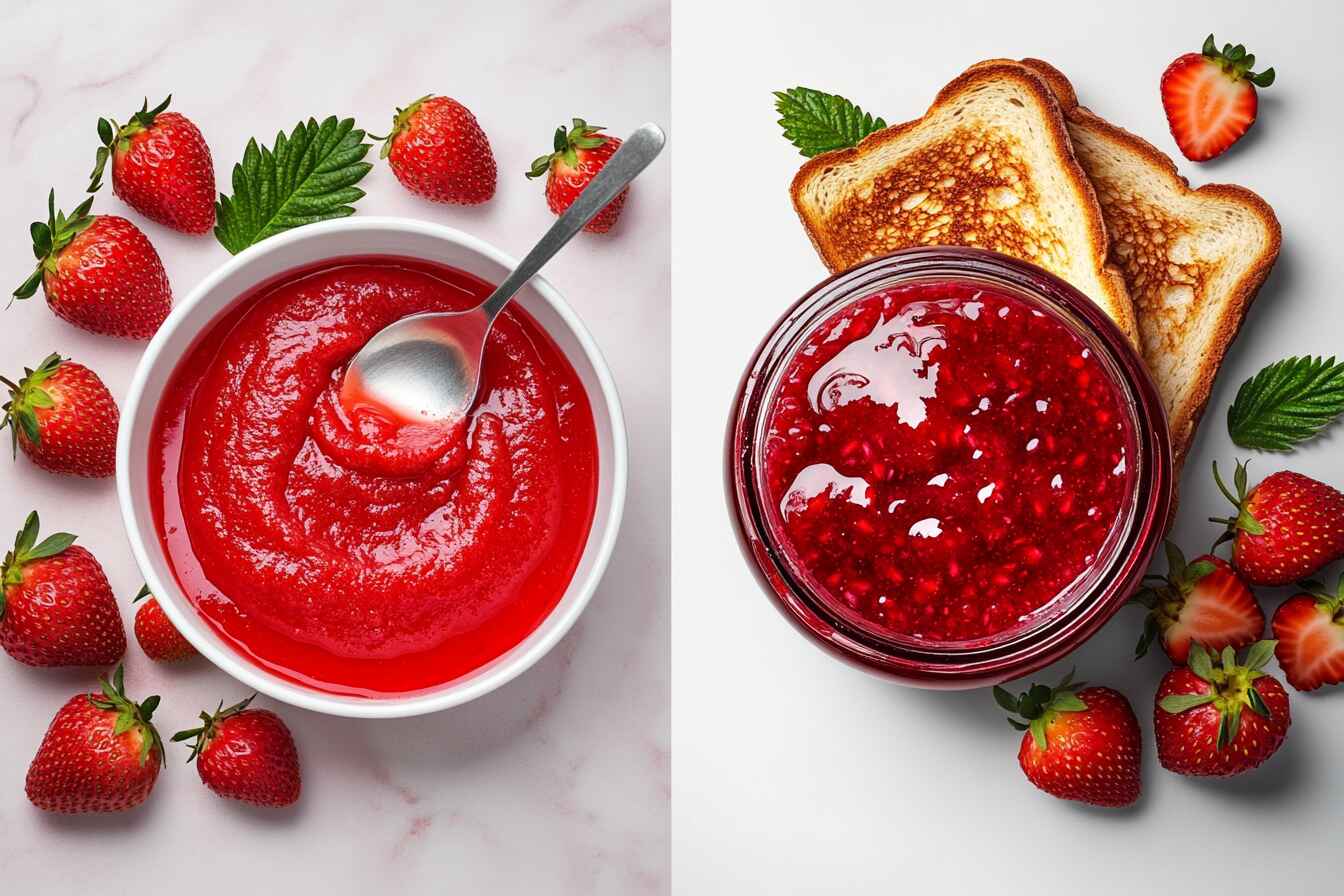Is strawberry puree the same as strawberry jam? When you’re whipping up a recipe, whether it’s a smoothie, a dessert, or even a savory dish, you may come across two ingredients that seem pretty similar strawberry puree and strawberry jam. But are they the same? Can you use one in place of the other? Let’s dive in and explore the differences, similarities, and how to make the best choice for your recipes. By the end of this article, you’ll have a clear understanding of when to reach for puree and when to grab the jam. 🍓
Table of Contents
Understanding the Basics of Strawberry Puree and Jam
Before we start comparing, let’s first take a moment to understand exactly what strawberry puree and strawberry jam are. Both are made from strawberries, but their textures, tastes, and uses differ quite a bit. Knowing these differences will help you decide which one to use based on your needs, whether you’re baking a cake, making a smoothie, or spreading it on toast.
What is Strawberry Puree?
Strawberry puree is simply blended or mashed strawberries. It has a smooth texture and is usually thinner than jam, which makes it ideal for a variety of uses where you want the strawberry flavor but not the thickness of jam.
Ingredients and Preparation of Strawberry Puree
The simplest way to make strawberry puree is by blending fresh or frozen strawberries. You don’t need to add anything else to get the purest flavor, though some people add a little sugar or lemon juice to enhance the taste. Here’s a basic breakdown:
| Ingredients | Quantities |
|---|---|
| Fresh Strawberries | 2 cups |
| Sugar (optional) | 1 tablespoon |
| Lemon Juice (optional) | 1 teaspoon |
To make strawberry puree, simply blend the strawberries (and any optional ingredients) in a food processor or blender until smooth. If the consistency is too thick, you can add a little water to thin it out. Voilà! You’ve got strawberry puree ready to go.
How to Make Strawberry Puree at Home
Making strawberry puree at home is incredibly easy, and it’s a fun project for the whole family. Start with fresh or frozen strawberries, remove the stems, and blend them into a smooth paste. You can adjust the sweetness with a little sugar if you prefer a sweeter taste. Here’s a quick guide:
- Wash and hull the strawberries. Remove the green tops and slice the berries into smaller pieces.
- Place the strawberries in a blender or food processor and blend until smooth.
- If it’s too thick, add a small amount of water to reach the desired consistency.
- Optional: Add a tablespoon of sugar or a squeeze of lemon juice to taste.
- Store the puree in an airtight container and refrigerate for up to a week, or freeze for long-term storage.
Common Uses for Strawberry Puree
Strawberry puree is incredibly versatile! Here are some common uses:
- As a base for smoothies or milkshakes
- In desserts like cheesecakes, ice cream, and panna cotta
- Mixed into yogurt for a fresh and fruity snack
- In sauces or salad dressings for a sweet kick
- For flavoring drinks like cocktails or mocktails
What is Strawberry Jam?
Strawberry jam is a thicker, sweeter spread made from mashed strawberries, sugar, and pectin. The key difference between jam and puree is the addition of pectin (or other thickening agents), which gives jam its consistency. Jam also typically contains more sugar, which helps preserve it for longer periods.
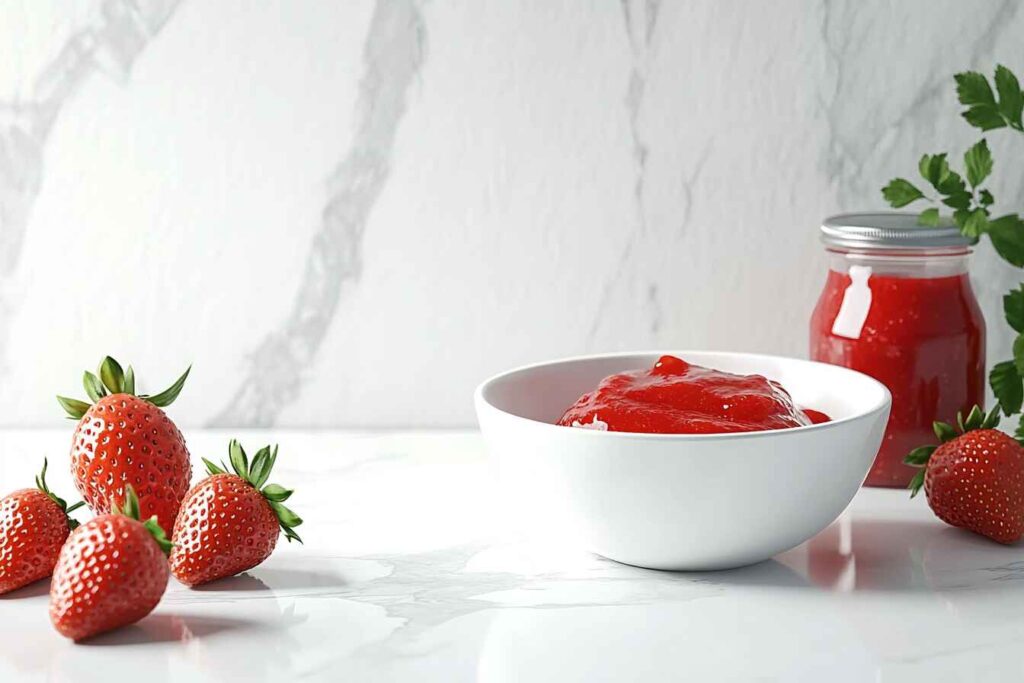
Ingredients and Preparation of Strawberry Jam
To make strawberry jam, you’ll need more than just fresh strawberries. You’ll also need sugar, pectin (a natural gelling agent), and sometimes lemon juice to help the jam set. Here’s a basic recipe for homemade strawberry jam:
| Ingredients | Quantities |
|---|---|
| Fresh Strawberries | 4 cups |
| Sugar | 3 cups |
| Pectin | 1 package (about 1.75 ounces) |
| Lemon Juice | 2 tablespoons |
Making strawberry jam requires a bit more effort than making puree. You need to cook the strawberries with sugar and pectin, which allows the mixture to thicken and set into a spreadable consistency. It’s a process that involves heating the ingredients to a high temperature to activate the pectin.
How to Make Strawberry Jam at Home
Making strawberry jam at home is a great way to enjoy fresh strawberries all year round. Here’s a simple process to follow:
- Wash and hull the strawberries, then mash or chop them into small pieces.
- Combine the mashed strawberries with sugar and lemon juice in a large pot. Stir in the pectin.
- Bring the mixture to a boil and cook for 10-15 minutes, stirring constantly.
- Test the consistency by placing a small spoonful on a cold plate. If it sets, it’s ready to jar!
- Pour the jam into sterilized jars, seal, and let it cool. Store it in the fridge or process it for long-term storage.
Common Uses for Strawberry Jam
Strawberry jam is a classic favorite! Here are some popular uses:
- Spread on toast or muffins for a sweet breakfast
- Used as a filling for cakes and pastries
- Mixed into yogurt or oatmeal for a delicious treat
- As a topping for ice cream or pancakes
- In sandwiches or as a glaze for meats
Key Differences Between Strawberry Puree and Strawberry Jam
Now that we know what strawberry puree and jam are, let’s break down their key differences. These differences can help you decide which one to use in your recipe depending on the outcome you’re looking for.
Texture and Consistency Differences
The most obvious difference between strawberry puree and strawberry jam is texture. Strawberry puree is smooth and thin, while strawberry jam is thick, spreadable, and has a more substantial consistency. If you’re looking for something to drizzle, puree is your go-to, but if you want a thick spread, jam is the better choice. Think of puree like a smoothie and jam like peanut butter one flows, and the other sticks.
Taste Profile: Sweetness and Flavor
While both strawberry puree and jam are sweet, the key difference in taste comes from the sugar content. Jam has a more concentrated sweetness due to the added sugar and pectin. Strawberry puree, on the other hand, maintains the fresh, natural sweetness of the fruit itself, though you can always add sugar to enhance the flavor. So, if you’re after a more intense strawberry flavor with a bit of sweetness, jam wins. But if you prefer the fresh, bright taste of strawberries, go with puree.
The Role of Sugar and Preservatives
Jam is typically made with a lot of sugar and sometimes preservatives to ensure it has a long shelf life. Strawberry puree, however, is made with just the fruit (and maybe a touch of sugar). If you’re avoiding sugar or preservatives, puree is a cleaner option. Jam’s added sugar also helps it set, which is why it’s much thicker.
Nutritional Differences
Since strawberry puree is essentially just blended fruit, it’s lower in sugar and calories compared to strawberry jam. Jam can be quite sugary, which increases the calorie count, but it also has a higher concentration of fruit flavor. If you’re watching your sugar intake or looking for a healthier option, strawberry puree might be the way to go. 🥄
We’ve covered the basics of both strawberry puree and jam. But what about using them in your recipes? Stay tuned for the next part, where we’ll dive into whether you can substitute one for the other, and explore the common problems and solutions you might encounter with each. 😋
Can Strawberry Puree Be Used as a Substitute for Strawberry Jam?
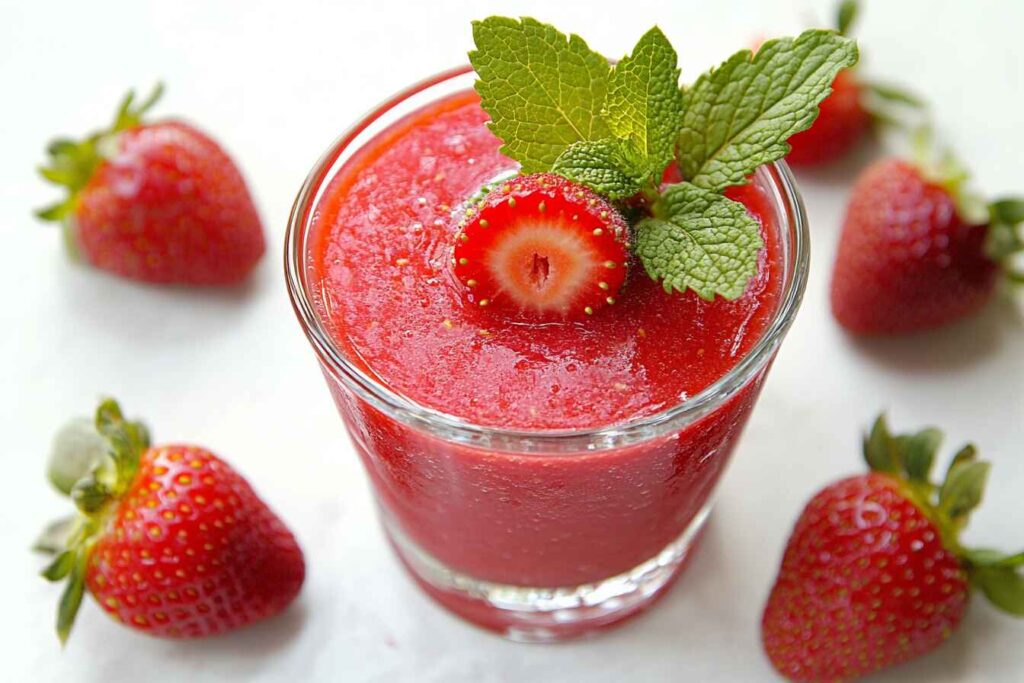
So, what if you’re in a pinch and don’t have the ingredient your recipe calls for? Can strawberry puree be used instead of strawberry jam, or vice versa? The answer is, it depends! Let’s look at the pros and cons of each to help you decide when to make the swap and how to adjust your recipe.
Pros and Cons of Substituting Strawberry Puree for Jam
Strawberry puree is thinner and less sweet than strawberry jam, which can be a challenge depending on your recipe. But there are some situations where using puree in place of jam makes perfect sense:
- Pro: If you’re looking for a fresher, fruitier flavor, strawberry puree is an excellent choice. It adds a natural, vibrant strawberry taste without the overwhelming sweetness of jam.
- Pro: Strawberry puree works wonderfully in smoothies, milkshakes, or sauces, where the texture of jam might be too thick.
- Con: If your recipe relies on the thickness of jam (such as for a spread), using puree can result in a runnier consistency.
- Con: Because puree lacks the sugar and pectin, it might not provide the same level of sweetness or gelling as jam, which could affect your recipe’s final taste and texture.
If you decide to swap, here are a few tips:
- If you need extra sweetness, consider adding a little sugar or honey to your puree.
- To achieve a thicker texture, you could cook the puree down or add a thickening agent like cornstarch or agar-agar.
How to Adapt Recipes When Using Puree Instead of Jam
When substituting strawberry puree for jam, you’ll need to make a few adjustments in your recipe. Here are some things to consider:
- Texture: If your recipe requires a spreadable texture, you might want to thicken the puree. You can do this by simmering it on the stove to reduce it and remove some of the water content.
- Sweetness: Since puree is less sweet, add sugar or another sweetener to taste. This is especially important in desserts like cakes or pastries, where sweetness is a key component.
- Consistency: If you’re using the puree in a filling, it may not hold up as well as jam. Consider mixing the puree with a thickener like cornstarch or gelatin to help it set.
Common Problems and Solutions When Using Strawberry Puree or Jam
Both strawberry puree and strawberry jam can be tricky to work with at times, especially if you’re not familiar with how they behave in different recipes. Here are some common problems and their solutions.
Problem: Strawberry Puree is Too Runny for Recipes
One of the biggest challenges with strawberry puree is that it can be too watery for some recipes, especially if you’re using it as a filling or a topping. If you need a thicker consistency, here’s how you can fix it:
- Simmer the Puree: Put the puree in a saucepan over low heat and simmer it for about 10-15 minutes to allow some of the water to evaporate, thickening the mixture.
- Add a Thickener: Cornstarch, agar-agar, or gelatin are great thickeners. Mix a small amount into the puree and cook for a few minutes until it thickens to your desired consistency.
- Blend with Other Ingredients: If you’re making a dessert like a tart or a cake, you can blend the puree with other thick ingredients like whipped cream or cream cheese to give it more body.
Solution: How to Thicken Strawberry Puree
If you’re struggling with a runny puree, the best solution is to reduce it by cooking it slowly. Alternatively, you can add a natural thickener like pectin, agar-agar, or gelatin to help it set. These options are especially helpful if you need the puree to hold its shape in a recipe like jam-filled pastries or as a filling for pies.
Problem: Strawberry Jam is Too Sweet or Thick
On the flip side, if you’re using strawberry jam and find it’s too sweet or thick for your recipe, don’t worry! There are easy ways to adjust it:
- Thin It Out: Add a bit of water or fruit juice (like lemon juice or orange juice) to the jam to thin it out. Heat the mixture on the stove and stir until you reach the desired consistency.
- Reduce the Sweetness: If the jam is too sweet, mix in some plain yogurt, cream cheese, or even fresh mashed strawberries to balance the flavor.
- Use Less: Sometimes, simply using a smaller amount of jam can help control the sweetness without sacrificing flavor.
Solution: Adjusting the Sweetness and Consistency of Jam
If your jam is too sweet, you can always tone it down by adding some fresh fruit or a squeeze of citrus juice. If it’s too thick, try heating it with a bit of liquid. Experiment with these adjustments until you get a consistency and flavor that works for your dish. 🍓
When to Choose Strawberry Puree Over Jam (and Vice Versa)
Now that you understand the differences and know how to troubleshoot issues with both strawberry puree and jam, let’s talk about when to use each. Here are some guidelines:
Choosing Puree for Smoothies and Desserts
If you’re making smoothies, milkshakes, or desserts like sorbet, mousse, or panna cotta, strawberry puree is your best option. It blends easily and gives you that fresh strawberry flavor without the heaviness of jam. Puree is also great for drizzling over desserts or mixing into whipped cream for a light and fluffy topping.
Choosing Jam for Spreads and Baking
If you’re looking for something to spread on toast, muffins, or pancakes, or if you need a filling for cakes, tarts, or pastries, strawberry jam is the way to go. Its thick, sticky texture and intense sweetness make it perfect for these applications. Plus, it holds up well in baked goods and won’t run out of your cake layers.
Strawberry Puree vs. Jam: Which One is Healthier?
While both strawberry puree and jam can be part of a healthy diet, they differ when it comes to calories and sugar content. Strawberry puree is much lower in sugar and calories, which makes it the healthier option if you’re trying to keep your sugar intake low. Jam, on the other hand, is typically packed with sugar, making it higher in calories. Let’s compare them nutritionally:
| Nutrient | Strawberry Puree (per 100g) | Strawberry Jam (per 100g) |
|---|---|---|
| Calories | 50 kcal | 250 kcal |
| Sugar | 10g | 60g |
| Fiber | 2g | 1g |
| Fat | 0g | 0g |
As you can see, strawberry puree is far lower in calories and sugar. However, jam provides a more concentrated flavor and is great for sweet dishes and preserving strawberries for longer periods. The best choice depends on your dietary needs and how you’re using the ingredient.
Creative Recipes Using Strawberry Puree and Jam
Now that you know the differences and how to troubleshoot problems, let’s wrap up with some recipe ideas that use both strawberry puree and jam!
Strawberry Puree Recipe Ideas
- Strawberry Smoothie: Blend strawberry puree with banana, yogurt, and a splash of almond milk for a refreshing treat!
- Strawberry Sorbet: Mix strawberry puree with a bit of sugar and lemon juice, freeze, and enjoy a delicious homemade sorbet.
- Strawberry Pancake Topping: Drizzle strawberry puree over pancakes for a lighter alternative to syrup.
Strawberry Jam Recipe Ideas
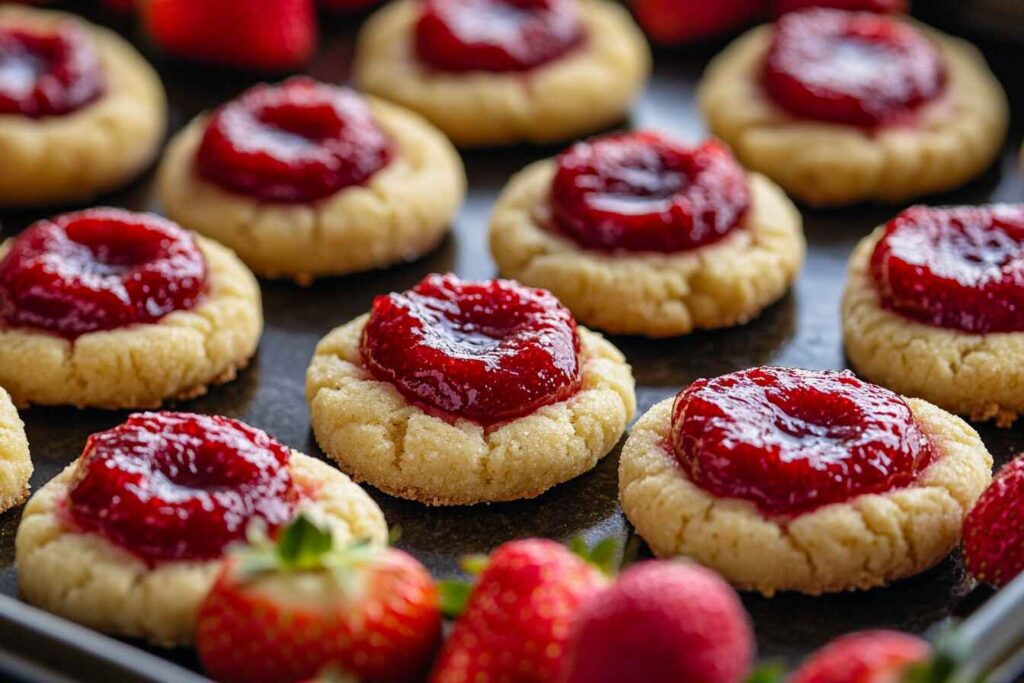
- Jam-Topped Toast: Spread a generous layer of strawberry jam on your morning toast or muffin for a sweet start to the day.
- Jam-Filled Pastries: Use strawberry jam as a filling for croissants, danishes, or thumbprint cookies.
- Jam Glaze for Roasted Meats: Add a spoonful of strawberry jam to your favorite glaze recipe for a sweet and savory touch on roasted meats.
How Long Do Strawberry Puree and Jam Last?
Both strawberry puree and jam have good shelf lives, but they need to be stored properly. Here’s how long each one lasts:
Storage Tips for Strawberry Puree
Strawberry puree lasts about 5-7 days in the fridge, but you can freeze it for up to 6 months if you want to preserve it for a longer time. Just make sure to store it in an airtight container.
Storage Tips for Strawberry Jam
Strawberry jam can last for 1-3 months in the fridge once opened. If you seal it in sterilized jars and process it, it can last for up to a year in the pantry. Be sure to check for mold or changes in smell before using.
Frequently Asked Questions (FAQs)
1. Can I use strawberry puree instead of jam in recipes?
It depends on the recipe. If the recipe requires a thick, spreadable consistency (like for toast or pastries), jam is the better option. However, if you want a fresher, fruitier taste for smoothies, desserts, or sauces, strawberry puree can be a great substitute. If using puree instead of jam, you may need to adjust for sweetness and thickness by adding sugar or a thickening agent like cornstarch.
2. Which one is healthier: strawberry puree or strawberry jam?
Strawberry puree is generally healthier because it contains only blended strawberries, making it lower in sugar and calories. Strawberry jam, on the other hand, contains added sugar and sometimes preservatives, making it higher in calories and less suitable for those watching their sugar intake.
3. How long does strawberry puree last compared to strawberry jam?
Strawberry puree: Lasts about 5-7 days in the refrigerator but can be frozen for up to 6 months.
Strawberry jam: Can last for 1-3 months in the refrigerator once opened, and up to a year in a sterilized, sealed jar stored at room temperature.
Conclusion: Is strawberry puree the same as strawberry jam?
Both strawberry puree and strawberry jam are fantastic ingredients, but they serve different purposes in cooking and baking. Strawberry puree is lighter and fresher, while strawberry jam is thicker, sweeter, and often used as a spread or filling. By understanding the key differences and how to troubleshoot issues, you can easily choose the right ingredient for your recipe. Whether you’re adding fresh fruit flavor to a smoothie or creating a rich jam-filled pastry, both options have their place in the kitchen! Happy cooking!
Print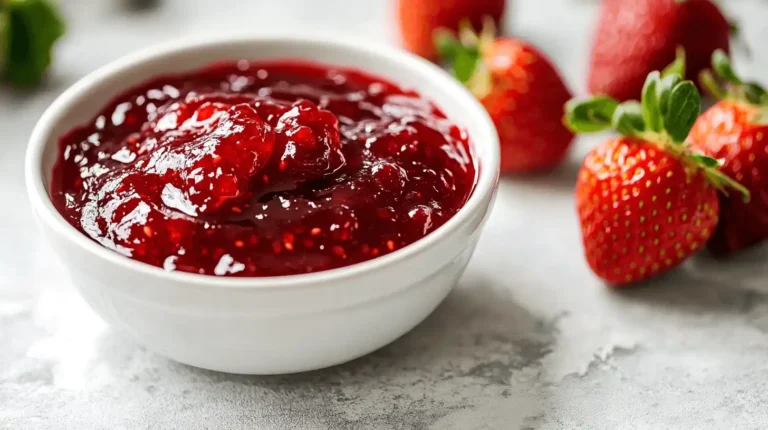
Is Strawberry Puree the Same as Strawberry Jam?
This homemade strawberry jam is a simple, delicious way to capture the sweet, fresh flavor of strawberries. Perfect for spreading on toast, pancakes, or using as a filling for pastries, this jam is sure to become a kitchen favorite.
- Total Time: 35 minutes
- Yield: 4-6 jars
Ingredients
4 cups fresh strawberries, hulled and chopped
2 cups granulated sugar
2 tablespoons lemon juice
1/4 cup water
1 packet fruit pectin (optional for a thicker jam)
Instructions
Prepare the Strawberries: Place the strawberries in a large pot and mash them with a potato masher or fork to your desired consistency. For a smoother jam, mash more, or for chunkier jam, leave some larger pieces.
Cook the Mixture: Add the sugar, lemon juice, and water to the strawberries in the pot. Stir to combine and bring the mixture to a boil over medium-high heat. Stir frequently to prevent burning.
Simmer the Jam: Once it reaches a boil, reduce the heat and let it simmer for about 10-15 minutes, stirring occasionally. If you’re using pectin, add it now according to the packet instructions.
Check for Set: To check if the jam is ready, place a small spoonful on a cold plate and let it cool for a minute. Run your finger through it – if it wrinkles and doesn’t flood back into the space, it’s done.
Jar the Jam: Once the jam has thickened to your liking, remove it from the heat and carefully spoon it into sterilized jars while still hot. Seal the jars tightly and allow them to cool completely.
Notes
If you prefer a smoother jam, you can blend the mixture with an immersion blender before boiling.
- Prep Time: 15 minutes
- Cook Time: 20 minutes
- Category: Jam, Spread
- Method: Stovetop
- Cuisine: American
- Diet: Vegetarian

